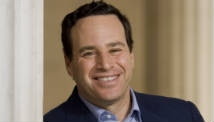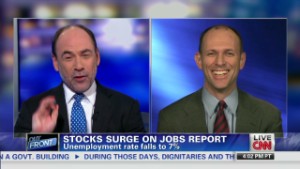Editor's note: David Frum, a CNN contributor, is a contributing editor at The Daily Beast. He is the author of eight books, including a new novel, "Patriots," and a post-election e-book, "Why Romney Lost." Frum was a special assistant to President George W. Bush from 2001 to 2002.
(CNN) -- According to the statisticians, the U.S. economy has been expanding since June 2009.
Yet for millions of unemployed, the recovery has not even begun.
Even today, 4½ years after the economy touched bottom, 1.3 million fewer people are working than in 2007. At the recent pace of job creation, not until August 2014 will as many Americans be working at nonfarm payroll jobs as were working before the recession of 2008-2009.
 David Frum
David Frum It's getting late. And it's getting dangerous. Since World War II, economic expansions have averaged 58 months between recessions. January 2014 will be month 54. Could another recession arrive before we've put back to work everyone who lost a job in the last recession? The answer seems almost certainly: yes.
Recessions can occur for three main reasons:
1) The monetary authorities tighten money to squelch inflation.
2) Some external event jolts the economy.
3) During an expansion, investors build too much capacity, suddenly realize they've overbuilt and abruptly cut back.
 Economic impact of November jobs report
Economic impact of November jobs report In real life, more than one of these events can happen at once. The 1974-75 recession was caused both by the oil shock of 1973 and by interest-rate tightening to fight inflation. The 2001-2002 recession was caused both by the terror attack of 9/11 and also by a sudden end to the surge of Internet investment.
Recessions can be made worse by financial mistakes. The United States hugely over-invested in housing between 2002 and 2007. Financial institutions then packaged the loans in ways that hyper-charged what could have been an ordinary downturn in the U.S. housing market into a global financial debacle.
Each and any one of causes 1, 2 and 3 could well occur in the near future.
All this talk of Federal Reserve "tapering" is code for tightening money. When the Fed does finally execute its taper, the economy could slump. We live in a big world full of potential nasty events. And after five years of ultra-cheap money, investors and affluent Americans have overextended themselves in all kinds of ways. The U.S. stock market especially looks dangerously overbought.
Not since 1937 have Americans suffered a second burst of job losses before all the unemployed of the previous round were put back to work. Yet it seems almost inevitable that such a recession-before-full-recovery will strike sometime in the next few years.
To put it bluntly: The great American job machine is breaking down.
After the severe recession of 1974-75, then the worst since World War II, it took only 10 months for the total number of people employed to recover to the pre-recession peak. In no recession between 1945 and 1990 did it ever take longer than 11 months to put everybody back to work.
Since 1990, however, job recovery after recessions has proceeded much more slowly. It took fully 21 months for employment fully to recover from the recession of 1990-91, 18 months for employment fully to recover from the recession of 2001-2002.
Fortunately, both recessions were comparatively mild. The total number of jobs lost was not hugely great, and so the slow pace of employment recovery affected comparatively few people.
But what if the United States suffered both a deep recession and a slow job recovery? Before 2007, few imagined such a possibility. Today, that's our new reality: a slump deeper than anything seen since World War II and a pace of employment recovery slower than anything seen since World War II -- and all with another recession slowly coming due.
Follow us @CNNOpinion on Twitter.
Join us at Facebook/CNNOpinion.
{ 0 comments... read them below or add one }
Post a Comment